Welcome to the delightful world of pears, where succulent sweetness meets crisp freshness in every bite. As your gardener guide, I invite you to explore the fascinating realm of these beloved fruits. Pears, members of the Rosaceae family, belong to the genus Pyrus, boasting a rich history dating back thousands of years. Pears are a sweet and juicy fruit that has been around for centuries. They are an excellent source of fiber, containing more than other popular fruits like apples and oranges.
In this article, we’ll look at the health benefits of pears, the different types available, how to select one that is ripe and ready to eat and some creative ways to incorporate them into recipes. So let’s get started- everything you wanted to know about pears!

What are Pears?
Pears, scientifically classified under the genus Pyrus, are deciduous fruit-bearing trees prized for their delectable fruits. These trees belong to the Rosaceae family, which also includes apples, cherries, and peaches. Pears are renowned for their graceful, spreading habit, adorned with glossy, ovate leaves that flutter in the gentlest breeze, providing a verdant canopy under which their fruits flourish.
Pears come in wide different varieties with unique flavors and textures. Whether you’re looking to add some sweetness to your salad or want something to snack on between meals, pears are a great choice. With their origins traced to regions spanning from Asia to Europe, pears have graced tables and orchards across the globe, captivating palates with their diverse flavors and textures.
From the delicate fragrance of blossoms in spring to the bountiful harvests of autumn, pears enchant both the senses and the soul. Join me as we delve deeper into the cultivation, varieties, and cultural significance of these luscious fruits, cultivating a deeper appreciation for nature’s bounty.
The fruit itself is a marvel of nature’s ingenuity. It is typically characterized by its distinctive shape, which ranges from spherical to pyriform (pear-shaped). Pears exhibit a diverse array of skin colors, including shades of green, yellow, red, and russet, with some varieties boasting blushes and speckles that lend them a captivating allure.
History and Origin of Pears:
The history and origin of pears trace back thousands of years, showcasing a rich tapestry of cultural significance and botanical evolution. Pears are believed to have originated in the region stretching from the Caucasus Mountains of Eurasia to northern Iran, where their wild ancestors, Pyrus caucasica and Pyrus nivalis, still thrive in their natural habitats.
Pear cultivation dates back to ancient times, with evidence suggesting that they were among the earliest fruits domesticated by humans. Archaeological findings, including fossilized remains and depictions in ancient artwork, attest to the presence of cultivated pears in regions such as Mesopotamia, Egypt, and China as early as 4000 BCE.
The Age of Exploration facilitated the global dissemination of pears, as European explorers and colonists introduced cultivated varieties to new lands during their voyages. Pears found their way to the Americas, Africa, and Asia, where they adapted to diverse climates and became integral components of local cuisines.
Different Types of Pears:
There are many different types of pears available on the market. Some of the most popular varieties include:
- Bartlett – Perhaps the most well-known pear variety, the Bartlett pear is prized for its sweet, juicy flesh and buttery texture. It has a classic pyriform (pear-shaped) appearance and a smooth, green skin that turns yellow as it ripens. Bartlett pears are excellent for eating fresh, canning, and cooking.
- Bosc – Bosc pears are renowned for their elegant appearance and distinctively elongated neck. Their russeted skin ranges from golden brown to cinnamon in color, and their flesh is dense and crisp, with a rich, honeyed flavor. Bosc pears are excellent for baking, poaching, and pairing with cheeses.
- Anjou – Anjou pears are characterized by their squat, slightly squat shape and smooth, green or red skin. They have dense, juicy flesh with a mild, sweet flavor. Anjou pears are versatile and can be enjoyed fresh, sliced into salads, or used in cooking and baking.
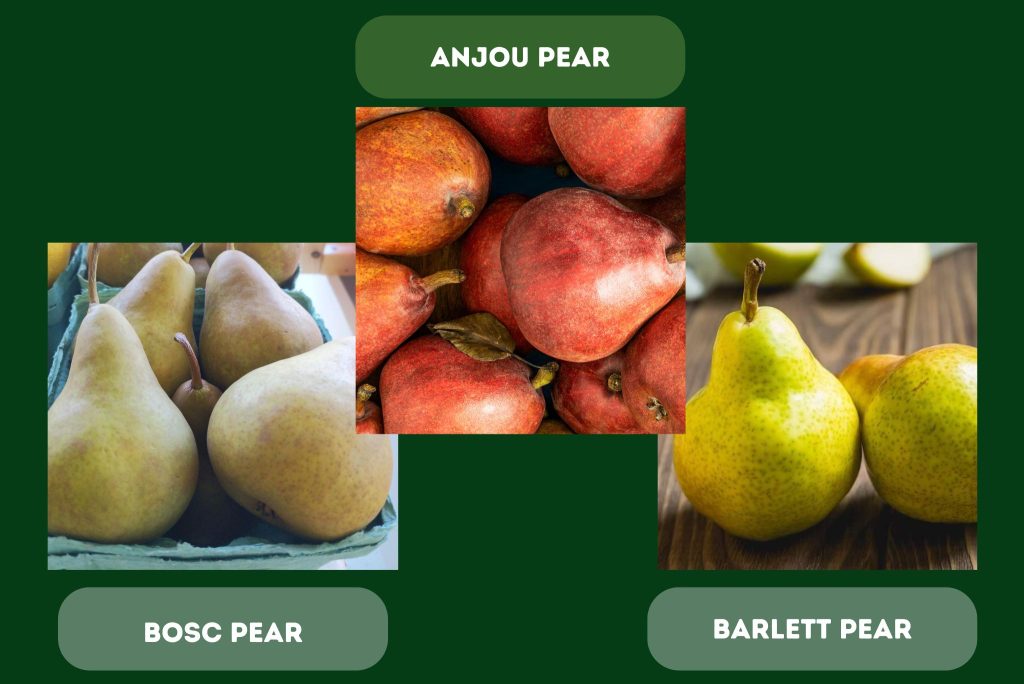
Health Benefits of Pears:
Pears offer a plethora of health benefits that make them a valuable addition to any diet. Rich in dietary fiber, pears promote digestive health by preventing constipation and supporting a healthy gut microbiome. Furthermore, their low calorie content makes them a satisfying snack option for those watching their weight, while their natural sweetness helps curb cravings for sugary treats.
Packed with essential vitamins and minerals such as vitamin C, potassium, and copper, pears contribute to overall well-being. Vitamin C boosts immune function and supports skin health, while potassium helps regulate blood pressure and reduce the risk of heart disease.
Additionally, the antioxidants found in pears, including flavonoids and phenolic compounds, neutralize harmful free radicals, reducing the risk of chronic diseases like heart disease and cancer. Moreover, certain compounds in pears, such as quercetin and kaempferol, exhibit anti-inflammatory properties, further enhancing their health benefits.
Incorporating pears into your diet, whether fresh, in salads, or in desserts, is a delicious way to support digestive health, heart health, and overall wellness.
Uses of Pears:
Pears are incredibly versatile in the kitchen, serving a multitude of purposes. They can be enjoyed raw, cooked, or used as a delightful addition to desserts and savory dishes alike. Their juicy sweetness pairs wonderfully with savory ingredients like cheese or nuts in salads, elevating the flavor profile of meals. Incorporating seasonal fruits like pears into your culinary repertoire adds a delicious touch to meals and snacks, enhancing their overall appeal.
Not only are pears readily available year-round, but they also lend themselves well to a variety of culinary applications. From juicing and baking into pies and cobblers to poaching and making jams, pears can be transformed into a wide array of delicious treats. They even make fantastic additions to smoothies, imparting a unique flavor to your favorite recipes.
In summary, pears are incredibly versatile and offer a wide range of uses in the kitchen and beyond. With their abundance of vitamins, minerals, and delightful flavor, incorporating pears into your diet is a simple and enjoyable way to reap the benefits this fruit has to offer.
How to Plant Pears Trees?
Pears are a popular and delicious fruit with wide varieties available. Planting pears is relatively straightforward, although it does require some patience. Depending on your climate, you may need to take extra steps to ensure your pear tree thrives. This section will guide you through the steps necessary for successful pear planting.
Choosing The Right Pear Tree:
The first step in planting a pear tree is choosing the right variety of trees for your climate and soil type. Selecting the appropriate pear tree variety is crucial for successful cultivation. Consider factors such as climate, chilling hours (required for fruit set), disease resistance, and pollination requirements. Choose a pear tree cultivar that is well-suited to your region’s climate and soil conditions.
Location:
Pear trees thrive in locations that receive full sun, with at least 6-8 hours of direct sunlight daily. Ensure the planting site has well-drained soil to prevent waterlogging, as pear trees are susceptible to root rot in overly wet conditions. Adequate air circulation around the tree is also essential to reduce the risk of fungal diseases.
Soil Preparation:
Prepare the soil before planting by loosening it to a depth of at least 12-18 inches (30-45 cm). Remove any weeds, rocks, or debris from the planting area. Conduct a soil test to assess pH levels and nutrient content. Pear trees prefer slightly acidic to neutral soil with a pH range of 6.0-7.0. Amend the soil with organic matter such as compost or well-rotted manure to improve soil structure and fertility.
Planting The Pear Tree:
When planting a pear tree, follow these steps:
- Dig a hole that is twice as wide and slightly deeper than the tree’s root ball.
- Gently remove the pear tree from its container or loosen the roots if it’s bare-rooted.
- Place the tree in the center of the hole, ensuring the graft union (if present) is above the soil level.
- Backfill the hole with the amended soil, gently firming it around the roots to remove air pockets.
- Mulch around your newly planted tree to help conserve moisture and reduce weed growth.
Care After Planting:
After planting, provide ongoing care to ensure the health and vigor of the pear tree:
- Watering: Keep the soil consistently moist, especially during the tree’s first growing season. Water deeply to encourage deep root growth, but avoid waterlogging.
- Mulching: Apply a layer of organic mulch, such as wood chips or straw, around the base of the tree to retain soil moisture, suppress weeds, and regulate soil temperature.
- Pruning: Prune the pear tree annually during its dormant season to promote a strong framework, improve air circulation, and remove dead or diseased branches.
- Fertilizing: Apply balanced fertilizer according to the tree’s specific needs based on soil test results and growth patterns.
Planting a pear tree can be a rewarding experience, as there are wide delicious varieties to choose from. With the right variety and site selection, proper soil preparation, and regular care, you can ensure that your new tree will thrive. Enjoy the fresh fruits of your labor in just a few years.
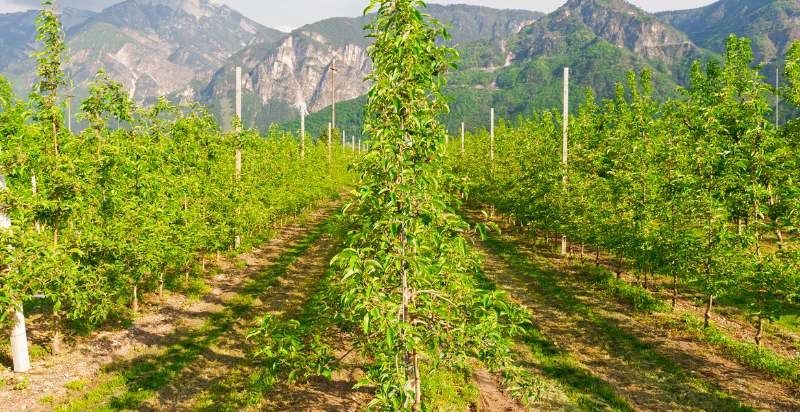
How to Care for and Grow Pear Trees?
- Prune the tree annually– Pear trees should be pruned annually to promote healthy growth and encourage fruit production. Start by removing any dead, diseased, or broken branches and any water sprouts (shoots coming directly off of main stems). Then, thin out any overly dense areas in the canopy so light can reach all parts of the tree. Finally, cut back any overhanging branches so they don’t touch the ground.
- Support the branches – As pears are heavy fruits, you may need to provide support for your tree’s branches to prevent them from breaking under the weight of the fruit. This can be done with stakes, trellises, or wires tied around the trunk of your tree.
- Monitor pests and diseases— Pests such as codling moths or codling worms can damage pear trees if left unchecked. Inspect your tree regularly and use insecticides or other pest management tactics when necessary. Also, watch for signs of disease, such as leaf spots, cankers, and discolored foliage, which may indicate a more serious problem.
- Provide adequate water – Pear trees need plenty of water, especially during their first few years as they establish their root systems. After that, you should water your tree deeply once a week during dry spells. When watering your pear tree, ensure that the soil around the trunk is wet to its dripline (the edge of the branches). This will ensure that all parts of the tree are getting enough moisture.
- Fertilize regularly – Pear trees need fertilizer to produce healthy fruit. Use an organic fertilizer formulated for fruit trees, such as composted manure or fish emulsion, and apply it once a year in the early spring. Be sure to follow the instructions on the package for dosage and application.
Follow these tips, and you’ll be well on your way to successfully growing and caring for your pear tree! Enjoy the delicious.
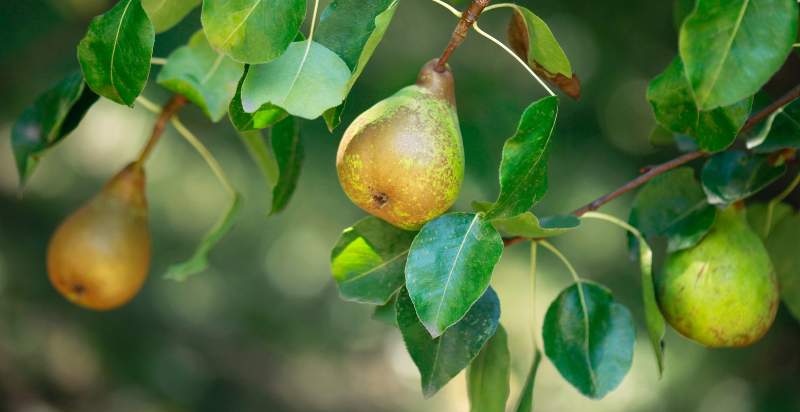
Preventions from Pests and Diseases:
You should practice good overall orchard management to prevent pests and diseases from affecting your pear tree. This includes regular pruning of dead or damaged branches, monitoring for signs of disease or pests, and immediately removing infected fruit from the tree. Here are some preventive measures you can take:
- Select Resistant Varieties: Choose pear tree varieties that are resistant to common pests and diseases prevalent in your area. Resistant cultivars can help minimize the risk of infestation or infection.
- Site Selection: Plant pear trees in well-drained locations with good air circulation and full sun exposure. Avoid planting in low-lying areas prone to waterlogging, as excess moisture can promote fungal diseases.
- Proper Planting: Ensure proper spacing between pear trees to allow for adequate airflow, which helps prevent fungal diseases. Plant trees at the appropriate depth and avoid planting too deeply, as this can lead to root rot.
- Soil Management: Maintain soil fertility and pH levels within the optimal range for pear trees. Conduct regular soil tests and amend the soil as needed with organic matter and balanced fertilizers to provide essential nutrients.
- Monitoring and Inspection: Regularly inspect pear trees for signs of pests, such as insect damage or egg masses, and symptoms of diseases, such as leaf spots or powdery mildew. Early detection allows for prompt intervention and prevents the spread of infestations or infections.
- Integrated Pest Management (IPM): Implement an IPM approach that combines cultural, mechanical, biological, and chemical control methods to effectively manage pests and diseases while minimizing environmental impact. This may include using beneficial insects, trapping, pruning, and judicious pesticide application when necessary.

How to Harvest a Pear Tree?
Harvesting a pear tree requires careful consideration of the maturity and ripeness of the fruit. The harvest time will vary depending on the variety but is generally between late summer and early autumn.
The best way to tell if pears are ready to be harvested is by tasting them (unless sprayed with an anti-ripening agent). Fully ripe pears will be slightly soft when gently squeezed along one side. If they still seem hard or unripe, leave them on the tree for another few days before checking again.
Once you’ve determined that the pears are ready for harvesting, it’s important to pick them carefully so as not to damage the fruit or the tree. A gentle approach is best, using a long-handled picking bag or ladder to reach higher branches.
Once harvested, pears should be washed and stored properly to retain their optimal flavor and texture for as long as possible. Ideally, pears should be refrigerated immediately after harvesting. They will keep up to 2 weeks when stored this way. If you need to store them long-term, they can also be frozen or canned.
With proper planting, care techniques, prevention from pests and diseases, and harvesting at the right time, you will have an abundance of delicious pears for years to come!
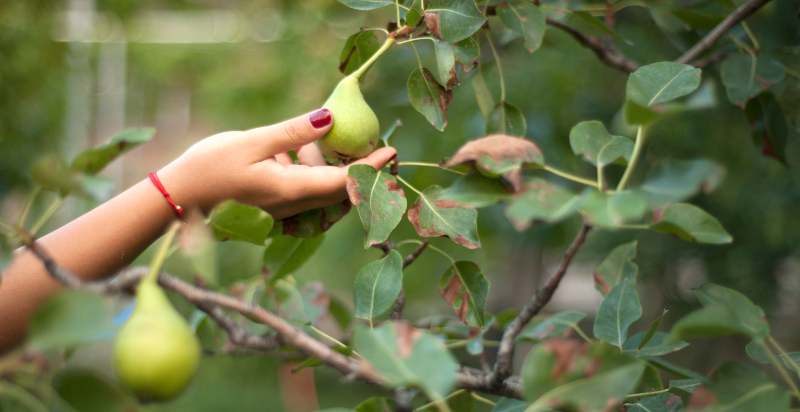
Where can be Pear Trees Found?
Pear trees can be grown in various regions across the United States, but their suitability depends on factors such as climate, soil conditions, and chilling requirements. Generally, pear trees thrive in temperate climates with distinct seasons, as they require a period of winter chill to initiate fruiting.
The West Coast, particularly Oregon, Washington, and California, is well-known for its thriving pear orchards. The cool, maritime climate and well-drained soils of this region are ideal for pear cultivation. Hood River Valley in Oregon, Yakima Valley in Washington, and Sacramento and San Joaquin Valleys in California are major pear-growing areas.
Parts of the Northeast, including New York, Pennsylvania, and New England states, have suitable climates for growing pears. While winters can be cold, certain pear varieties with low chilling requirements can thrive in this region.
How to Store Homegrown Pear Trees?
After harvesting, it’s important to store homegrown pears correctly to maintain their optimal flavor and texture for an extended period. Ideally, refrigerate pears immediately post-harvesting to preserve their freshness. Alternatively, they can be stored at room temperature for approximately 7-10 days. For longer-term storage, consider freezing or canning the pears.
To prepare pears for storage, ensure they are clean and dry before placing them in a plastic bag or container in the refrigerator. This practice helps prevent spoilage and prolongs the freshness of the pears. It’s also advisable to avoid storing ripe pears with unripe ones, as the ethylene gas emitted by ripe fruit may hasten the ripening process of surrounding fruits, causing them to become overripe prematurely.
Harvesting pears at the appropriate time and storing them properly using the aforementioned methods will contribute to a bountiful yield season after season.
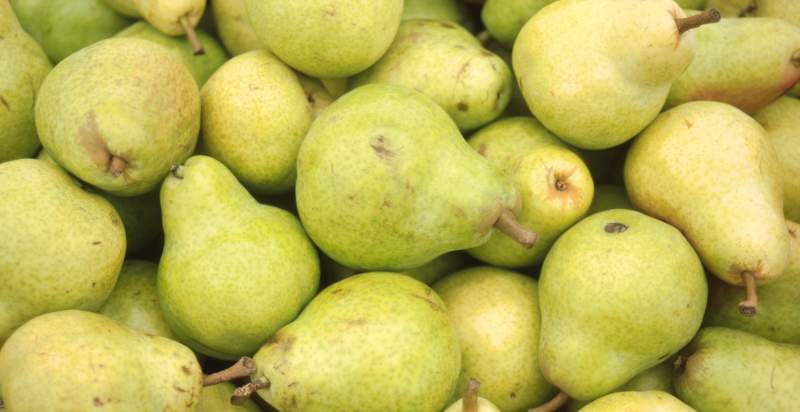
How to Use Pears?
Pears are a nutritious, delicious, and versatile fruit that can be eaten raw, cooked, or added to recipes. Here’s how to use them:
- To enjoy raw pears, cut them into cubes or slices and serve them as is. They make a great addition to salads and can also be used in smoothies to boost nutrition.
- Pears can also be cooked – they’re excellent when poached, baked, grilled, or caramelized with sugar and butter. Add them to oatmeal dishes, desserts, sauces, and even savory dishes like pork roast!
- When canning pears, make sure you peel off the skin before cutting it into pieces, so it doesn’t get mushy in the jar.
- Add pears to your favorite recipes, such as pies, cobblers, crisps, and tarts. They also make a great addition to muffins and quick bread!
- When baking or cooking pears, choose ripe but firm fruit that will hold up better during heating or freezing. If you’re using dried or canned pears, read the package instructions for the best results.
When using pears in recipes, there are a few things to remember. First and foremost, choose ripe but firm fruits so they hold up better during cooking and baking. If you’re using canned or dried pear products, follow the package instructions carefully to get the best results.
Also, when baking with pears, it’s best to use an acidic liquid like lemon juice as it will help keep them from becoming too mushy. Lastly, when substituting pears for apples in recipes, remember that they are sweeter and softer, so you may want to reduce the amount of sugar or baking time slightly.
Pears are a delicious and nutritious fruit that can be enjoyed raw and cooked in various recipes! With these tips on how to use them, you’ll be able to enjoy this sweet treat all year long.

Potential Risks from Pears:
Although pears are nutritious and tasty, they may pose risks if not handled or eaten properly. Here are a few potential hazards to consider:
- Pears contain small amounts of cyanogenic glycosides (pyridoxine), which can cause illness if ingested in large doses. Remove the core and seeds before eating them raw.
- Allergic reactions can occur when consuming pears as some people are sensitive to their proteins, especially those with pollen allergies or asthma. If you experience any signs of an allergic reaction after eating pears, seek medical attention immediately.
- Pesticides used on pears may be harmful if ingested. This is even more of a concern for children, as their bodies are still developing and less capable of handling toxins. It’s best to purchase organic pears or wash them thoroughly with water before eating them.
- Pears contain fermentable carbohydrates known as FODMAPs (fermentable oligosaccharides, disaccharides, monosaccharides, and polyols), which can cause digestive discomfort in individuals with irritable bowel syndrome (IBS) or other gastrointestinal disorders. High-FODMAP foods like pears may trigger symptoms such as bloating, gas, and abdominal pain in susceptible individuals.
Because it is possible to encounter potential risks while consuming pears, handling and eating them properly is important to minimize the risk of illness or allergic reaction. Purchasing organic pears, washing thoroughly, and removing the core/seeds before consumption can help reduce these risks.
Conclusion:
When purchasing pears from the store, look for ones that are firm but not too hard and have a deep color. Avoid any with brown spots or bruises, as they may be overripe. It’s also important to store them properly—ideally in a cool, dry place out of direct sunlight and away from other fruits like apples, bananas, and tomatoes, which emit ethylene gas that can cause premature ripening.
Make sure not to mix ripe pears with unripe ones—the ethylene gas emitted by the ripening fruit may cause other fruits around it to speed up the ripening process and become mushy. Generally, pears are best enjoyed soon after being purchased or picked as they don’t store well and can become mealy if left at room temperature for too long.
- Dino Melons: Description, Flavor, Benefits, And Uses - April 29, 2025
- Pear Trees: Planting, Growing, and Harvesting Pears - March 27, 2024
- Runner Beans (Scarlet Runner Bean): Description, Flavor, Benefits, And Uses - March 21, 2024

16 thoughts on “Pear Trees: Planting, Growing, and Harvesting Pears ”
Comments are closed.